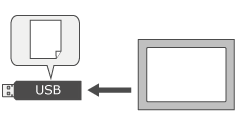Exporting and Importing Alarms
Exporting from and Importing to the Screen Editing Software
In the screen editing software, you can run export and import operations from the Variables editor toolbar.
For more details, see Exporting and Importing Variables.
Check the file version of CSV or TXT outputs in the [FileVersion] line of the output file.
Exporting from Display Unit
Alarm data can be exported to external storage.

Alarm data is exported by following ways:
- By executing Export Alarm Data operation.
Export Alarm Data An index file listing the exported files is created automatically in the export folder.
The following file formats are supported for exporting alarm data:
- TXT file (.txt, UTF-8 (without BOM))
- CSV file (.csv, UTF-8 (without BOM))
For information on file formats, see the following.
You can see the exported file using software program such as Microsoft Excel.
- You can configure the date format and time format in the first two columns of exported data in the [Date Format] and [Time Format] properties.
[Target01] property window > [Function] tab > [Options] tab > [Export] > [Content]
For information, refer to the following.
[Date Format]
[Time Format] - In the [All Alarms] Property window, when [Detect Modification]
is enabled for [Export Data], an alphanumeric string is added
to the first row in exported files. This alphanumeric string is
used by the Export
File Validation Tool to detect changes to the file
data. When using this tool, do not delete or edit the alphanumeric
string.

For information on the Export File Validation Tool, see the following.
Checking the Modification in Exported File The data output is formatted as follows:
- Strings are encapsulated by double-quotation marks (").
E.g. "This is a string" - Special characters "=", "+", "-",
"@", TAB, and ENTER that appear at the beginning of an entry
are prefixed with a single-quotation mark (').
E.g. "'=1+2"
- Strings are encapsulated by double-quotation marks (").
When exporting alarm data with [Alarm Mode] set to [Log], if there is exported [Log] alarm data from a different project in the destination folder, the data may not be exported correctly. Delete the index file (AlarmExportFileInfo.dat) in the destination folder before exporting.
Export Data Settings
You can configure the export data settings in the [Export Data] area in the [All Alarms] properties window. For more details, refer to the following.
Export Status
You can save the status of the export process.
You can configure the export status settings in the [Export Status] area in the [All Alarms] properties window. For more details, refer to the following.
Checking the Modification in Exported File
You can check if there is a modification in the exported file by using Export File Validation Tool.
- Start up the Export
File Validation Tool.
This tool is installed in the following path:
Start Menu > BLUE *.* > BLUE *.* Export File Validation Tool
- From the Export File Validation Tool, click […] and select the file.
- Click [Check]
to detect a modification in the exported file.
If no modifications are found, [OK] is displayed.
If a modification is found, [NG] is displayed.
- This tool can be distributed from BLUE installation media ([\Tools] folder).
- If you installed this
tool with a stand-alone installer, use the following to start
the tool.
Start Menu > Pro-face > BLUE TOOLS Export Validation Tool